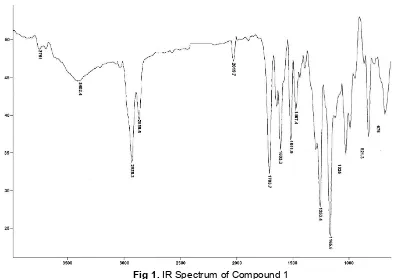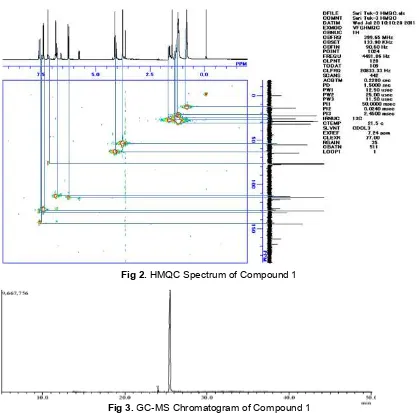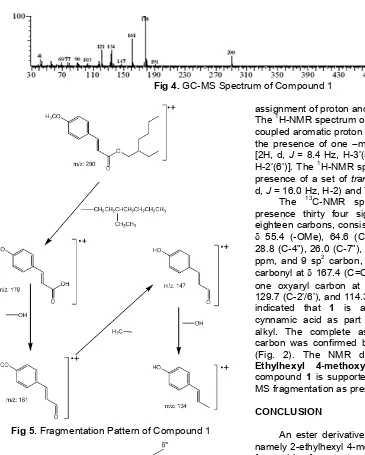ABSTRACT
An ester derivative of 4-methoxycynnamic acid, i.e. 2-ethylhexyl 4-methoxy cynnamate was isolated for the first time from the chloroform extract of stem bark of Xylocarpus moluccencis (Lamk) M. Roem) (Meliaceae) along with
β-sitosterol and stigmasterol. The first structure was elucidated with the help of various spectroscopic techniques, including IR, GC-MS, and NMR spectra. Two last structures were determined by comparison with the reported compounds in literature. These compounds were also found in the hexane extract of the plant.
Keywords:Ester of 4-methoxycynnamic acid;β-sitosterol; stigmasterol; Xylocarpus moluccencis
ABSTRAK
Suatu turunan ester dari asam 4-metoksisinamat, yaitu 2-etilheksil 4-metoksisinamat telah berhasil diisolasi untuk pertama kalinya dari ekstrak kloroform kulit batang tumbuhan Xylocarpus moluccencis (Lamk) M. Roem) (Meliaceae) bersama dengan β-sitosterol dan stigmasterol. Struktur senyawa pertama telah dielusidasi dengan bantuan berbagai teknik spektroskopi mencakup spektrum IR, GC-MS, dan NMR. Struktur dua senyawa berikutnya telah ditentukan melalui perbandingan dengan senyawa yang telah dilaporkan dalam literatur. Dua senyawa ini telah pula ditemukan pada ekstrak heksana dari tumbuhan tersebut.
Kata Kunci:Ester 4-metoksisinamat;β-sitosterol; stigmasterol; Xylocarpus moluccencis
INTRODUCTION
Meliaceae contains various types of compounds, especially pentacyclic triterpenoid and limonoids [1]. As known that Xylocarpus genus belongs to the family Meliaceae, therefore the plant can be predicted consisting of the compounds. The plants belonging to
Xylocarpus genus are composed of 3 species, i.e., X. granatum, X. moluccensis and X. rumphii. According to information from NAPRALERT database developed by University of Illinois at Chicago, several types of compounds present in plants of Xylocarpus genus can be classified into groups as follows: carbohydrates, glyceride ester, isoquinoline alkaloids, quinolone alkaloids, phenolic compounds, secoiridoid monoterpenes, steroids, and triterpenes.
Literature research on chemical constituents consisted of X. moluccensis reported that the species contain type of monoterpenoid and limonoid compounds, with marker compound, i.e. Xylomollin and Xyloccensin 1,2 [2]. Continues phytochemical research on the wood of the plant have obtained three new limonoids, i.e.
xyloccensins G, H, and I [3]. Two new limonoids, namely xyloccensin I and xyloccensin J, have also been isolated from the plant andX. granatum[4-5].
Past our investigations on the chemical constitutes of the stem bark of mangrove plant, X. moluccensis (Lamk) M. Roem), one of Meliaceous plants, have yielded two steroidal compounds, i.e. stigmasterol (2) and β-sitosterol (3) from hexane extract [6]. As part of our continuing search for bioactive insecticidal natural products from mangrove plants [7], we now just describe the isolation and structural elucidation of an ester derivative of cynnamic acid, named 2-ethylhexyl 4-methoxycynnamate (1) belonging to be a phenolic compounds from chloroform extract ofX. moluccensis.
EXPERIMENTAL SECTION
Materials
Fig 1.IR Spectrum of Compound 1
collected in March, 2009 from Kebun Raya Purwodadi, Pasuruan. The plant was identified by Herbarium LIPI Staff, Purwodadi, and its specimen was deposited in the Herbarium. Materials are used for vacuum liquid chromatography (VLC) using Si Gel Merck 60 GF254,
gravitational column chromatography (GCC) using Si Gel Merck 60 (60-70 mesh), always monitored by thin layer chromatography (TLC) using plate of Si Gel Merck Kieselgel 60 F254, 0.25 mm (20 x 20 cm). Organic
solvents used in the research might be pro analysis (p.a.) and distillated, i.e., methanol, chloroform, hexane, and ethyl acetate. The spray reagents used for TLC was 1% FeCl3 solution for phenolic compounds and
Liebermann-Burchard for triterpenes and steroids.
Instrumentation
Isolated compound (1) was measured by using IR spectrophotometers with Buck Scientific M500. 1H- and
13
C-NMR using spectrometer of JEOL JNM-AL300/AL400 FTNMR, operated at 399.65 MHz (1H) and 100.40 MHz (13C), with tetramethylsilane as internal standard, and spectrometer of GC-MS Shimadzu QP-2010S. Melting point of compound1 was determined on Electrothermal Apparatus.
Procedure
The milled and dried stem bark (3 kg) of X. moluccencis was extracted with chloroform (10 L) for
24 h and the process was repeated three times. The chloroform extract, on removal of the solvent under reduced pressure by evaporation, gave a brown residue (15 g). A portion (7.5 g) of the total chloroform extract were subjected by VLC using hexane-ethyl acetate system (100:0 ~ 0:100) followed by methanol to yield 14 fractions. This chromatographic step was repeated twice on portions of 7.5 g each of the chloroform extract. Five primary fractions were ultimately obtained on combining the eluates on the basis of TLC. The second fraction (2.3 g) was again fractionated by GCC using hexane : ethyl acetate (96:4) to yield 57 fractions. Furthermore, the fractions can be grouped on the basis of TLC to give 6 fractions, i.e., fraction A (1-9), B (10), C (11-25), D (26), E (27-35), and F (36-57). Fraction A (1-9) is allowed in open room to give yellowish residue. Next, the residue is crystallized from hot methanol to yield a white crystal as compound2 and 3 to be a mixture (30 mg). When performed by Liebermann-Burchard reagent, the mixture gave blue color indicating the presence of steroidal compounds. Then, the fraction D (26) was evaporated occurred a white precipitate. The precipitate was, then purified by recrystallization using hexane to afford compound 1 as needle white crystal (pure enough) (10 mg). The purity of the compound 1
can also be shown by GC-MS chromatogram (see Fig. 3). When tested by FeCl3 1% (in methanol), it showed
Fig 2.HMQC Spectrum of Compound 1
Fig 3.GC-MS Chromatogram of Compound 1
Table 1.1H and13C NMR data of compound1
Compound 1
No
H(multiplicity,Jin Hz) C
1 - 167.4
2 6.36 (d, 16.0) 115.8 3 7.64 (d, 16.0) 144.2
1’ - 132.1
2’(6’) 7.48 (d, 8.4) 129.7 3’(5’) 6.90 (d, 8.4) 114.3
4’ - 161.3
-OMe 3.84 (s) 55.4
1’’ 4.18 (t) 64.6
2’’ 1.31 (m) 31.8
3’’ 1.69 (m) 29.2
4’’ 1.56 (m) 28.8
5’’ 1.28 (m) 22.6
6’’ 0.88 (t) 14.1
7’’ 1.25 (m) 26.0
8’’ 0.88 (t) 14.1
RESULT AND DISCUSSION
2-Ethylhexyl 4-methoxycynnamate (1)
Needle white crystalline form, m.p. 35–36 °C. -IR (KBr) ʋ (cm-1) = 2925.3, 2859.5, 1703.7, 1603.3, 1511.9, 1467.4, 1253.4, 1165.6, and 821.3 cm−1 (see Fig. 1). -1H- and13C-NMR (chloroform-deuterium): See Table 1. -GC-MS, m/z: 290 (C18H26O3) (see Fig. 4).
Compound 1 was obtained as needle white crystalline form, m.p. 35–36 °C. Its molecular formula was established as C18H26O3 in which Double Bond
Fig 4.GC-MS Spectrum of Compound 1
Fig 5.Fragmentation Pattern of Compound 1
functionalities (see Fig. 1). The evidence of the data is supported by GC-MS (m/z: 290) (C18H26O3) (see Fig. 4)
and NMR data (see Table 1).
The analysis of its NMR data, including NMR one dimension (1H- and 13C-NMR) and two dimension (HMQC spectrum only), allowed for an unambiguous
assignment of proton and carbon signals (see Table 1). The1H-NMR spectrum of1displayed two sets ofortho -coupled aromatic proton signals in A2X2spin system for
the presence of one –methoxyphenyl group at 6.90 [2H, d,J = 8.4 Hz, H-3’(5’)], 7.48 d [2H, d, J = 8.4 Hz, H-2’(6’)]. The1H-NMR spectrum of 1also indicated the presence of a set of trans configuration at 6.36 (1H, d,J= 16.0 Hz, H-2) and 7.64 (d,J= 16.0 Hz, H-3).
The 13C-NMR spectrum of 1 displayed the presence thirty four signals representing significant eighteen carbons, consisting of 9 sp3carbon signals at 55.4 (-OMe), 64.6 (C-1”), 31.8 (C-2”), 29.2 (C-3”), 28.8 (C-4”), 26.0 (C-7”), 22.6 (C-5”), and 14.1 (C-6”/8”) ppm, and 9 sp2 carbon, including one ,β-unsaturated carbonyl at167.4 (C=O), 144.2 and 115.8 (C=C) and one oxyaryl carbon at 161.3 (C-4’), 132.1 (C-1’), 129.7 (C-2’/6’), and 114.3 (C-3’/5’). These spectral data indicated that 1 is an ester of 1,4-disubstutited cynnamic acid as part of the structure attached an alkyl. The complete assignment of the protonated carbon was confirmed by means of HMQC spectrum (Fig. 2). The NMR data were consistent with 2 Ethylhexyl 4-methoxycynnamate. The proposed compound 1 is supported by small detail data of GC-MS fragmentation as presented in Fig. 5.
CONCLUSION
An ester derivative of 4-methoxy cynnamic acid, namely 2-ethylhexyl 4-methoxycynnamate was isolated from chloroform extract of Xylocarpus moluccencis
(Lamk) M. Roem (Meliaceae) along with stigmasterol andβ-sitosterol. This is the first report of the chemical constituents of this species, and the type of compound isolated was in accordance with the established information ofXylocarpusgenus.
ACKNOWLEDGEMENT


